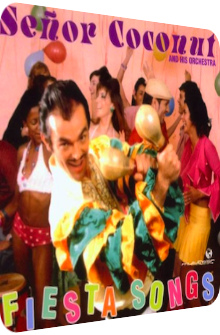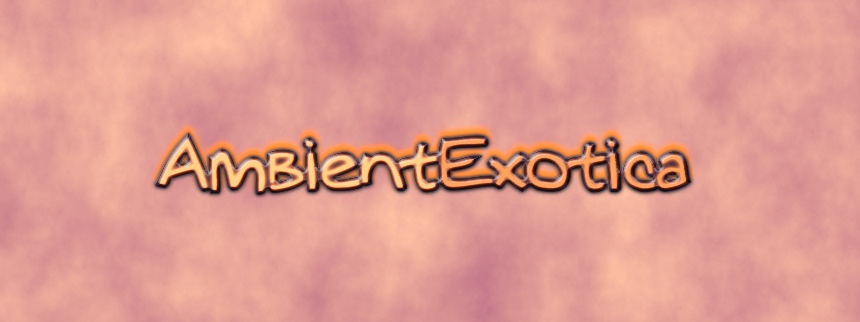
Señor Coconut
Fiesta Songs
2003
Señor Coconut is the moniker of Uwe Schmidt who migrated to Chile and tries to merge music of electronic origin or even Rock classics with Latin melodies and exotic percussion. The production-related fascination of his work derives from the fact that he started as a solo artist, but masked this fact by coming up with a faux-band, a commonplace and yet highly interesting approach that has been done numerous times before, especially when the music of the respective artist consists of a fusion of various genres and music styles. T
he first album of The Tikiyaki Orchestra as well as all albums of Kenny Sasaki & The Tiki Boys are pitch-perfect examples of the faux-band phenomenon, as is Jan Jelinek's band The Exposures, who is otherwise known for his Exotica and field recording collages nowadays. Long story short: Fiesta Songs by Señor Coconut and his orchestra marks an important milestone in Schmidt's Latin career, for this album features a real band and a setup of proper instruments and drum kits – the recording offers a deepness and three-dimensionality not found on electronic albums, but which can only be achieved in real band setups in the studio.
Another important inclusion is the purposefully schmaltzy voice of the talented percussionist and singer Argenis Brito who enhances the hot-tempered feeling of the album very well. And let me tell you in advance that Fiesta Songs is awesome and inspiring. While only 3 of 11 tracks are original pieces conducted and arranged by Schmidt himself, the rest of the roster consists of magnificent and awe-inspiring Merengue and Cha Cha Cha renditions of megahits such as Michael Jackson's Beat It, Jean-Michel Jarre's Oxygene and Deep Purple's Smoke On The Water! And boy, these songs not only survive this procedure, but sparkle more vividly than ever, capturing the hearts of Synth Pop and Rock fans. The band consists of Argenis Brito, Carsten Skov on the marimba, Morten Grønvad on the vibraphone, Klaus Löhr on the trombone and Lars Vissing on both the trumpet and the flügelhorn. As usual, I invite you to the deep track analysis in the coming paragraphs, but if you want to know how Señor Coconut's music-related approach resembles the strategic decisions of the exotic 50's, scroll down to the last paragraph.
The album starts with a Cha Cha Cha rendition of Deep Purple‘s 1972 hit Smoke On The Water, Argenis Brito and a backing choir are replacing Ian Gillan and delivers a magnificent performance that is both lightheartedly funny due to the inclusion of the world-famous guitar riff which is resembled via boiling hot trombone blasts and skillfully played bongos, and due to the innovative setup that remains faithful to the original. All of the lyrics are retained, and the clear-cut marimba sprinkles alongside the clanging percussion and Löhr‘s soothing trombone solo make this a Latin masterpiece, a term I don‘t coin that often in fear of overusing it.
But Señor Coconut truly offer a great song to two highly diverse audiences, both nostalgic baby boomer greasers as well as several new generations that seem to know even less about Latin music than about Deep Purple. I‘m not insulting anyone here! The charisma of Señor Coconut‘s version is just so shimmering that it propitiates two diverse groups and yet offers a new viewpoint on Latin music and its potential – yes, I‘m overanalyzing its impact, and I‘m fully aware of it, but this is the song that reaches all audiences alike. And if this weren‘t enough, the band even translated the lyrics into Spanish! Humo En El Agua is featured as a bonus track and amplifies the distinct sound – now everything is Latin, and the song sounds so much better and hotter in this version. A blast and a surprising inclusion on every party for the connoisseur as well as for the ignoramus.
Negra Mi ChaChaCha is next and is a colorful, glittering tune with typical Latin marimba note sequences that drift into melancholic territory only to burst into joyfulness seconds later; the primary mood, however, is bewailing and lamenting, while the song remains in fiesta territory. The bongos are beaten hectically, and the vibraphone plays in unison with the marimba, their two sounds become one. Brito and company are embedded perfectly into the mix, and neither the instruments nor the singers sound too dominantly.
Up next is a Merengue version of The Doors‘ Riders On The Storm, and the beginning is already highly promising for Exotica fans: thunderstorms, chirping birds and distant ocean waves build a delighting audio diorama, and once the first reverberating vibraphone notes occur, the listener considers him- or herself in Arthur Lyman‘s aurally painted lushness. The song gains traction and increases the tempo with quick maracas, vibrating trombones and hectically sung lyrics. Even though it‘s a Latin song, the focus on the vibraphone makes this a rather exotic song in general and one of my very favorites in particular. The curious but successful oscillation between several soli, tempo shifts and percussion pauses make this song as dynamic as it is soothing.
Another Cha Cha Cha song follows, and it is a rendition of Sade‘s Smooth Operator of 1984. The staccato brass bursts as well as their gleaming sunset sustain is utterly gorgeous. Placid vibraphone sparkles and marimba cascades further smoothen the Operator, and the setting is much more laid back than on any preceding song. The second section consists of a vividly sunset light-evoking brass solo with glaring staccato backings and the repetition of the refrain. Another clear winner.
After all these cover versions, the orchestra presents their first original: El Rey De Las Galletas is built upon a distinctive Bolero groove but starts with an intensely carnevalesque percussion mayhem for about 45 seconds. Soon, the band sings lyrics about cakes and the liquid marimba notes add a jungle atmosphere to the percussion heaviness. Worth mentioning is the middle section which consists of a reduced bongo groove and underlining bass guitar pluckings. Finally, the song returns to its richly texturized nature and features the refrain one last time all the while an array of exotic percussion is heard one last time.
Jean-Michel Jarre‘s iconic Oxygene Part 2 follows next and begins with orchestral drums and an unusual atmosphere of suspense and anticipation. Twinkling vibraphone bits and softened marimba notes enter the scene while the impetus of the drums increases. Opalescent brass thunders and echoey chants mark the high point of the song before the trombones play the main melody in a rather gentle way, while the backing instruments haven‘t lost any power. This is by far the most smashing song with the biggest vehemence, breaking with the formula while retaining the Latin flavor. Absolutely mind-blowing even at low volumes.
Elton John‘s Blue Eyes is also included. Seriously. It is rather horrible, unfortunately. This clichéd and way too slow love ballad isn‘t enhanced by the Cha Cha Cha transformation, but seems to be misplaced in the tremendously strong and playful surrounding of the other songs. Sure, there is that certain kind of fiestas that focuses on slow and gentle mating dances, but please, not here, not on this album. On the plus side, the brass section is very smooth and the vibraphones sparkle all the more in this surroundings, but after the infamous Oxygene Part 2, it is even harder to admire Blue Eyes. A rare dud on an album full of hits.
Fortunately, the following Las Maracas De Machín brings back the happiness and is another original piece that somehow transports an 80‘s feeling and style to the listener‘s ears with the help of especially twinkling brass sections and a slower beat overall. The focus clearly lies on the various trombones and trumpets, with only small and reduced mallet instruments interwoven in the mix. Michael Jackson‘s Beat It is the second and quickly-paced Merengue song and starts with a gorgeous bongo solo and clarion percussion. The version is far away from Jackson‘s original and is successful on that level. However, transfering Synth Pop or R‘n‘B hymns into Latin realms is always a dangerous affair, for the production quality and the melodies are so pitch-perfect in their original incarnations that every remix or alteration is destined to fail.
Señor Coconut and his band try to overcome these limiting factors through an increased tempo and terrific exotic percussion. It‘s a nice rendition of Beat It, but it doesn‘t capture or twist the magic in the same way than the band was able to accomplish on Smoke On The Water, Riders On The Storm or Oxygene Part 2. The final Electrolatino is the last original by Señor Coconut and intertwines a catchy rhythm with electronic modifications such as sampling lyrics, chopping them and playing them back in staccato style. Apart from these additions, the song inherits a proper Latin theme and is a beautiful finale to the album – which is grafted with the aforementioned Spanish version of Smoke On The Water as a bonus track.
Suddenly, it's 1958 again. What did Exotica artists try to accomplish in general? Well, they wanted to let the listener escape to foreign places. But as I've written in other reviews before, this escape must not be alienating or scary to the listener, hence the inclusion of well-known formulae and Western tonfolgen in order to smoothen the experience and providing a feeling of adventure and shelter. That's the reason why the percussion in Exotica songs was often times quite exotic, but the setting of most songs didn't usually capture the true Polynesian, African or even European – especially French and Spanish – spirit, but inherited the viewpoint of the United States. The second column of the genre's success is built on the tropification of well-known classics: Amral's Trinidad Cavaliers Steel Orchestra, for instance, provided calypso versions of U.S. classics, and vice versa were Latin classics like Poinciana or Taboo romanticized by Les Baxter and Co, making them available to a broader audience.
Uwe Schmidt tries the very same thing with his Señor Coconut project. World-famous hits are transformed into a different genre. While this idea sounds gimmicky or outright cheeky to a lot of listeners, the concept and the approach themselves are edel, because they introduce listeners to the idea of Latin music. It's not even fake Latin music, for the songs were recorded in parts in Chile and some of the band members were born in Latin countries. Fiesta Songs is clearly a joyful album with very strong tracks that doesn't take itself too seriously, however. Its importance is hidden with the help of a funny front artwork and a tracklist that is keen on a pop-sensationalist reaction. Still, I can't help myself but to adore the coherent quality as well as the Latin glamour of the world hits. This is one of Señor Coconut's best albums and a good hint of the further things he accomplished with both his faux- and real band.
The attraction of Fiesta Songs is clearly based on the premise of the surprising latinized songs, but Schmidt's own compositions are equally charming. This is the perfect party album and a clear winner even for those who have never encountered Latin music before. Strictly speaking, Fiesta Songs is no Exotica album, but since it contains the same ideas and tactics of the 50's maestros, it is a great proof for the repetition of music history and the comeback of certain genre-related patterns. Don‘t let the front artwork fool you: yes, it seems like a lackluster college band outing, but is in fact perfectly polished and raunchy enough to count as a proper Latin album … with welcoming bits of Exotica!
Exotica Review 045: Señor Coconut – Fiesta Songs (2003). Originally published on Mar. 3, 2012 at AmbientExotica.com.
